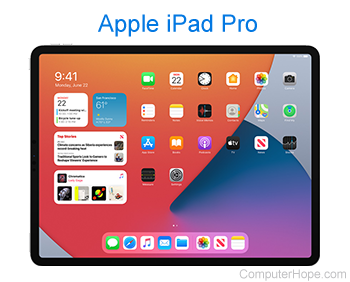Tablet computer history

Listed below are the important events in history relating to tablet computers, including release dates for many popular tablets and the technologies used with tablets.
1951
In his novel "Foundation," Isaac Asimov included details about a device called the Calculator Pad, which some people think could be a very early description of a tablet computer.
1971
The concept of a tablet computer was developed by Alan Kay in 1971. While more like a laptop than a tablet, Kay's Dynabook was a precursor to the tablet computer.
1979
The touch screen technology, which would later be used by tablet computers, was patented by four engineers at Hitachi in Japan in 1979.
1989
The GRiDPad was released by GRiD Systems in September 1989, utilizing an extended version of MS-DOS. It was considered the first tablet computer to be successful in the commercial market.
1992
Atari developed the ST-Pad (originally called the Stylus) in 1992, a device featuring an early form of handwriting recognition.
IBM announced its first tablet computer, the 2521 ThinkPad, in April 1992. It used the PenPoint operating system developed by GO Corporation.
1993
In 1993, Compaq released what is considered by some people to be the first 2-in-1 computer. It was named the Compaq Concerto. It could be a laptop and tablet, featured a pen for use with a touch screen display and a detachable keyboard. Unfortunately, the Concerto did not gain popularity for itself or 2-in-1 computers.
1994
The NewsPad project was started in 1994 by the European Union, to develop a device to deliver news electronically to users. Acorn Computers developed a touch screen tablet device named the NewsPad, for the project. The NewsPad was released in Spain in 1996 as a pilot program, but ended the program in 1997.
1996
Palm, Inc. released the first PalmPilot device in 1996, which featured the PalmOS and a stylus pen for interaction with the device. While the PalmPilot is considered a PDA (personal digital assistant) device, it helped pave the way for later tablet devices.
2000
Microsoft released the Pocket PC (personal computer), a PDA device, in April 2000. It featured the Windows CE operating system and a touch screen display.
2001
Ericsson Mobile Communications announced a tablet device, named the DelphiPad, in 2001. It featured a touch screen, a Netscape Navigator web browser, and a Linux operating system.
2005
Nokia released its first tablet computer, the Nokia 770, in 2005. Dubbed an "Internet tablet," it focused on Internet browsing and viewing news as use cases.
2008
Microsoft reportedly was developing a booklet tablet, named the Microsoft Courier, in 2008. The Courier had dual touch screen displays and could fold in half like a book. However, the Courier booklet tablet was canceled in 2010.
2009
The first Android-based tablets were released in 2009, including the Archos 5, the Camangi WebStation, the Ultra, and the Vega.
2010
Toshiba released the first booklet tablet computer on the commercial market in August 2010, the Toshiba Libretto W100. The Libretto W100 featured dual 7-inch touch screen displays and could fold in half like a book.

The first iPad tablet was announced by Apple on January 27, 2010, featuring a 9.7-inch touch screen display.
Samsung released its first tablet computer, the Galaxy Tab, on September 2, 2010, featuring a 7-inch touch screen display.
Barnes & Noble released its Nook Color device on November 16, 2010. It featured a 7-inch touch screen display and used an 800 MHz ARM Cortex-A8 processor.
2011
ASUS released its first 2-in-1 tablet computer, the ASUS Eee Pad Transformer, on March 30, 2011. It featured a 10.1-inch touch screen display and an optional keyboard that could be docked with the tablet, turning it into a laptop.

Amazon entered the tablet computer market with the release of the Kindle Fire in November 2011, which featured a 7-inch touch screen display.
2012
Apple released the first version of the iPad mini on November 2, 2012, featuring a 7.9-inch touch screen and 32 GB or 64 GB of storage.
2013
Microsoft released its first 2-in-1 tablet computer, the Surface Pro, on February 9, 2013. It had Windows 8 Pro 64-bit pre-installed and featured a 10.6-inch touch screen display.
The first gaming tablet was released by Razer, named the Razer Edge Pro, on March 1, 2013. It is a tablet computer designed for playing PC games, with the power and performance to do so. It featured an Intel Core i7 processor, 8 GB RAM, 256 GB SSD, NVIDIA GeForce GT 640M 2 GB video card, and a 10.1-inch display.
